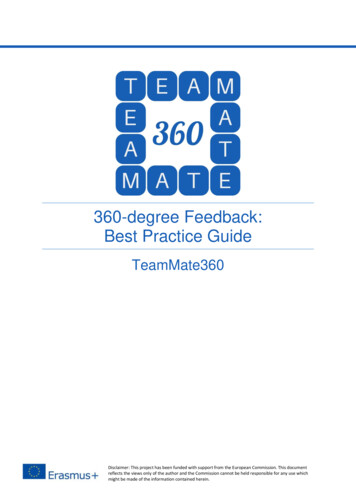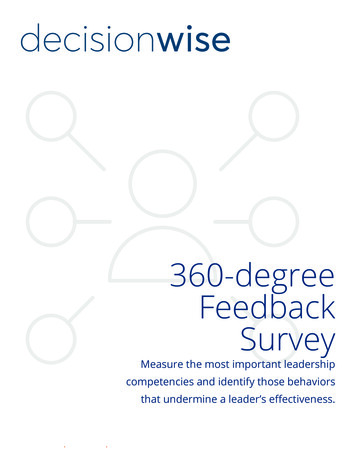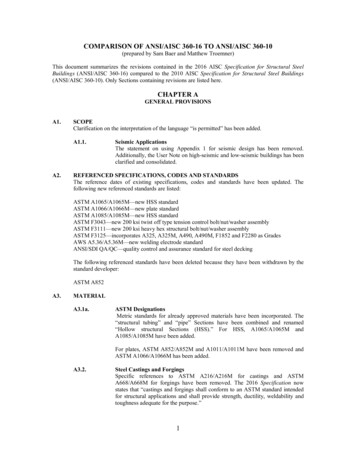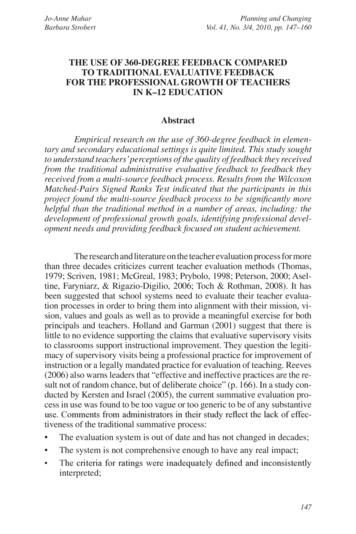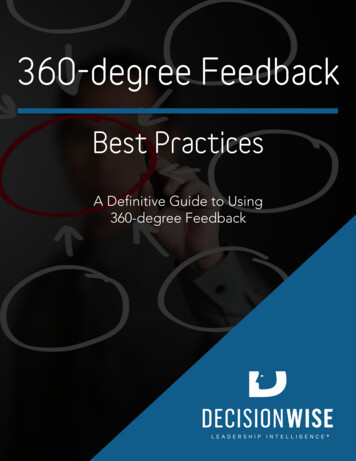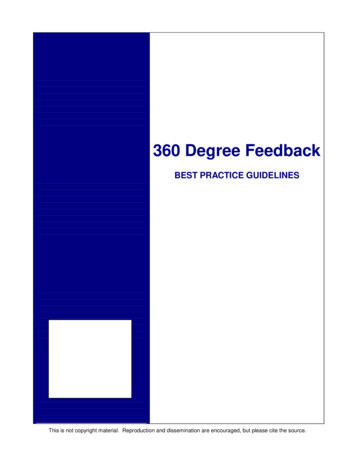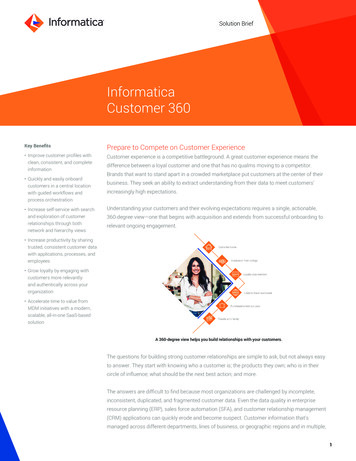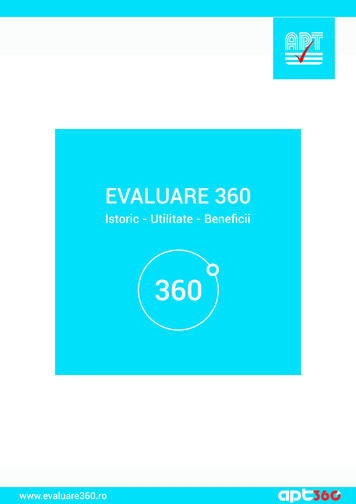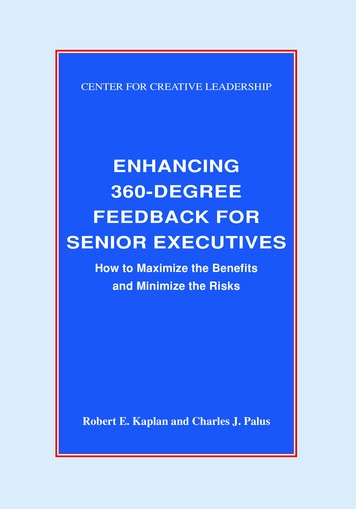
Transcription
CENTER FOR CREATIVE LEADERSHIPENHANCING360-DEGREEFEEDBACK FORSENIOR EXECUTIVESHow to Maximize the Benefitsand Minimize the RisksRobert E. Kaplan and Charles J. Palus
iENHANCING360-DEGREEFEEDBACK FORSENIOR EXECUTIVESHow to Maximize the Benefitsand Minimize the Risks
iiiENHANCING360-DEGREEFEEDBACK FORSENIOR EXECUTIVESHow to Maximize the Benefitsand Minimize the RisksRobert E. KaplanCharles J. PalusCenter for Creative LeadershipGreensboro, North Carolina
ivEnhancing 360-degree Feedback for Senior ExecutivesThe Center for Creative Leadership is an international, nonprofit educational institutionfounded in 1970 to advance the understanding, practice, and development of leadershipfor the benefit of society worldwide. As a part of this mission, it publishes books andreports that aim to contribute to a general process of inquiry and understanding in whichideas related to leadership are raised, exchanged, and evaluated. The ideas presented in itspublications are those of the author or authors.The Center thanks you for supporting its work through the purchase of this volume. Ifyou have comments, suggestions, or questions about any CCL Press publication, pleasecontact the Director of Publications at the address given below.Center for Creative LeadershipPost Office Box 26300Greensboro, North Carolina 27438-6300Telephone 336-288-7210 www.ccl.org/publications 1994 Center for Creative LeadershipAll rights reserved. No part of this publication may be reproduced, stored in a retrievalsystem, or transmitted, in any form or by any means, electronic, mechanical, photocopying,recording, or otherwise, without the prior written permission of the publisher. Printed in theUnited States of America.CCL No. 160Library of Congress Cataloging-in-Publication DataKaplan, Robert E.Enhancing 360-degree feedback for senior executives : how to maximize the benefits andminimize the risks / Robert E. Kaplan, Charles J. Palus.p. cm."CCL no. 160"—T.p. verso.Includes bibliographical references.ISBN 1-932973-47-81. Executives—Rating of—Methodology. 2. Feedback (Psychology). 3. Employees—Attitudes. 4. Self-evaluation. 5. Executives—Counseling of. I. Palus, Charles J. II. Title.HF5549.5.R3K36 1994658.4'07125—dc2094-23151CIP
vTable of ContentsAcknowledgments . viiPreface . ixIntroduction . 1A Closer Look at Enhanced Feedback . 2Sources of Data . 3Numerical ratings plus verbatim comments . 3Data from the workplace plus data from personal life . 3Data on behavior plus data on motivation . 3Data on the present plus data on early history . 3Choosing suitable sources . 4Follow-through . 5Possible Outcomes . 5Evidence of Gain . 5Evidence of Pain . 7Absorbing the Impact . 9Making Safe Use of Enhanced Feedback . 9Select the Right Staff . 9Select the Right Participants . 10The organization nominates . 11Self-selection . 11The service provider selects . 13Tide the Executive Through . 13Preparation . 14Stress the positive . 14The service provider should never attack or coerce . 15After the feedback session, make sure that the service provider stays intouch . 15The service provider should help the executive get closure . 16Challenge the executive to make real progress . 16Make sure that the service provider builds a strong relationship with theclient . 17Conclusion . 18Bibliography . 19
viiAcknowledgmentsWe would like to thank the following people for their helpful input: PatAlexander, Barry Berglund, Marilyn Butterfield, David DeVries, Susan Dorn,Bill Drath, Rebecca Henson, Fred Kiel, Connie McArthur, Cindy McCauley,Marie McKee, Eric Rimmer, Sharon Rogolsky, Jeff Staggs, Joan Tavares,Amy Webb, Randy White, Martin Wilcox, and Kathryn Williams.
ixPrefaceIn our development work with senior executives, we often make use ofa tool that we refer to in this paper as enhanced 360-degree feedback. Because of its power, a key issue in its implementation is informed choice. Thatis, we believe that everyone taking part in such feedback—the executive, theexecutive’s superior, the human resources representative, family, and the staffof the service provider—must be aware in advance of the possible benefitsand risks of participation. The HR representative plays a central role—notonly choosing the service providers who offer enhanced feedback and selecting the executives who participate but also in helping others make informedchoices—and so we have primarily addressed that group in this paper. Wedo think, however, that what we say here can also be of benefit to otherparticipants.What we have written, of course, bears the slant of our own experienceswith, and interpretations of, particular versions of these methods. Nonetheless, we have tried to approach enhanced feedback as an emerging generalclass of development interventions for senior managers. This class of intervention is characterized by greater power that seems to be needed to bringabout appreciable, sustainable improvements in the leadership exerted bysenior executives. (They don’t become perfect executives; just better ones.)But to employ that heightened power to good effect requires a very active,conscientious engagement by the key players at critical junctures. This reportdescribes the nature of that engagement.
1IntroductionIn the past few years, management development has increasinglyinvolved 360-degree feedback—an experience in which a person receives, inanonymous form, ratings of performance from peers, superiors, and subordinates; compares these with self-ratings; and perhaps gets limited coachingand sets goals for improvement. It aims to improve performance by providinga better awareness of strengths and weaknesses, and if the person is experiencing problems, it can be used to develop a more precise understanding ofthem and what to do in response.In general, 360-degree feedback is viewed as an effective developmenttechnique for all levels of management. Senior executives, however, sometimes require a richer feedback experience. We have worked for many yearswith programs offering such an experience, which we refer to here as enhanced 360-degree feedback or enhanced feedback.1Enhanced feedback, in addition to the features mentioned above, alsooffers some or all of the following: detailed verbatim descriptions; observations from family members and friends; psychometric measures of personalityand motivation; data on early, including family, history; and an extendedcoaching relationship with one or more professionals in leadershipdevelopment.Why do senior executives sometimes need more than standard 360degree feedback? From one perspective, it is because they face a muchbroader range of challenges than other managers and executives. In addition,based on our research (Kaplan, 1990, 1991; Kaplan, Drath, & Kofodimos,1991), we believe that there is another factor: the psychological makeup ofpeople who rise to high-level positions. Executives are often extremelyachievement-oriented, very forceful, and highly demanding. But such qualities can backfire. Executives can underperform or, perhaps even more serious,get outstanding results in the short run by sacrificing the organization’s abilityto maintain high performance in the long run.Standard feedback does not address performance at the psychologicallevel, focusing rather on modifying behavior alone; and little help is given to1The programs we have worked with are APEX and LeaderChange . APEX is offeredby the Center for Creative Leadership. LeaderChange is offered by Kaplan DeVries,Inc. A third program that provides enhanced feedback is New Foundations, offered byKRW Inc. Other programs that make use of what may be viewed as enhanced 360degree feedback are the ICE program of Personnel Decisions, Inc., and the Leadership atthe Peak program of the Center for Creative Leadership.
2Enhancing 360-degree Feedback for Senior Executivesthe person in actually applying the results. Also, standard feedback does nottypically deal with the general skepticism in organizations about the ability ofexecutives to change on the psychological level. In our work we have foundthat powerful forces seem to hold them more or less in place. Senior executives are successful people; not surprisingly, they are often reluctant to tamperwith what got them to where they are. And whatever their problems may be,they are, by virtue of their high position if not also the contributions theymake, treated daily in ways that suggest strongly that they are exceptional andshouldn’t need to change (Kaplan, Drath, & Kofodimos, 1985). Enhanced360-degree feedback, because of its scope and power, provides a way ofdealing with such resistance.Yet its power is also potentially harmful. We have not witnessed anycase in which permanent harm was caused by this type of feedback, but webelieve that certain standards should be adopted, certain procedures followed,and certain precautions taken to minimize the risk.2The purpose of this paper, then, is to lay out the potential advantagesand hazards of enhanced feedback. It is intended primarily for human resources managers who are responsible for the development of executives. HRmanagers are key because they are in a strong position to ensure good practice. They are responsible for deciding who participates; they select theservice provider; they oversee the activity; and they have a role to play ascoaches.In the remainder of this paper we will look at enhanced feedback and itsrationale in greater detail; provide evidence and examples of potential benefits and risks; and suggest guidelines for making safe and effective use of it.A Closer Look at Enhanced FeedbackEnhanced feedback goes beyond standard 360-degree feedback on twocounts—in the amount and the type of data collected and in its emphasis onimplementation.2Standards of ethical practice have been articulated for professionals working withindividuals in organizational settings (American Psychologist, 1992; Gellerman,Frankel, & Ladenson, 1990; Pope & Vasquez, 1991; Van Hoose & Kottler, 1985).Taking these standards seriously means assessing both the short- and long-term positiveas well as potentially negative impacts of each method; it means “informing the peoplewith whom we work about . . . purposes and goals . . . anticipated outcomes, limitations,and risks . . . in a way that supports their freedom of choice in activities initiated by us”(Gellerman et al., 1990, p. 168).
A Closer Look at Enhanced Feedback3Sources of DataThere are four sources of data in enhanced feedback: numerical ratingsplus verbatim comments; data from the workplace plus data from personallife; data on behavior plus data on motivation; and data on the present plusdata on early history.Numerical ratings plus verbatim comments. Numerical, scale-basedratings tend to leave recipients wondering what some of the numbers mean.This is even more true when, as is usually the case, the ratings come from anoff-the-shelf instrument; often the person is unclear as to how the genericitems apply to him or her in particular. Comments in their co-workers’ ownwords add an extra dimension. The two types of data used in tandem arepotent because—if the results on each tell a similar story, and they usuallydo—the message comes through clearly.Comments can be gathered using interviews or open-ended questionsthat co-workers respond to in writing. A drawback of using verbal commentsis that, even when they are reported back anonymously, the recipient may beable to identify who said what.Data from the workplace plus data from personal life. It is commonfor a person to exhibit similar behavior at home and at work—for instance,holding onto control or planning everything to the nth degree. When feedbackindicates that this is the case, the person is less likely to deny a behavior.Of course, there are usually also differences in behavior, but these too areinstructive.The way to gather data on personal life is to, in addition to interviewingthe executive, talk to family members and, perhaps, friends. This is unusualfor a management-development activity and extreme care must be exercised.Data on behavior plus data on motivation. We believe that if executives are to modify their behavior, they must consider what drives that behavior. This is where the psychological makeup of the person comes in. To besure, one’s psychological makeup is not readily amenable to change—andthat is a good thing—but neither is it completely immutable. At a minimum ithelps the cause of development if the executive is able to factor in the personal, emotional, inner side of his or her leadership. How to do this? One wayis to do a battery of psychological tests. Another way is to collect data onwhat other people feel is the individual’s motivation.Data on the present plus data on early history. Another way tounderstand the executive’s psychological makeup is to look into his or herpast. The principle here is simple: The child continues to live in the adult.One need only ask commonsense questions about an individual’s parents,
4Enhancing 360-degree Feedback for Senior Executivessiblings, family life, friends, performance in school, play, and so on, and thelikely formative influences emerge fairly clearly. There is always more tolearn about the connection between one’s past and the present, and the typicalexecutive has not given this much thought. One way to gather information onchildhood is to talk with the executive. It also helps to interview members ofhis or her original family and a childhood friend or two.Choosing suitable sources. Not all the sources of data described aboveneed to be used in every case. Taking basic 360-degree feedback as the given,the service provider, the HR representative, and the executive should choosecarefully what supplementary data sources to add. This will depend on theneeds of the executive and the organization and on available resources.With respect to benefit and risk, the more high-quality data and themore different types of data, the greater the potential impact, in both a positive and a negative sense. Even a basic 360-degree-feedback instrumentcarries a risk. In general, the greater the impact and more issues potentiallyraised, the greater the responsibility the provider has to the recipient.To highlight both the potential risks as well as the potential benefits ofenhanced 360-degree feedback to executives, we are concentrating in thispaper on the several data sources taken together. The power of such anintervention derives from how much data are fed back. One executive, whohad received enhanced feedback and who, because he was in some difficultyorganizationally, had received a higher proportion of negative feedback fromhis co-workers, remarked that the experience was “like having fifty performance appraisals at once.” The intervention’s impact also derives from thewide variety of data, which raises a range of basic issues—job and career,work and family, present and past, behavior and motivation. The effect is tovirtually flood the executive with data. As another executive observed aftergetting his report, “If you collect enough data on any phenomenon, the basicpatterns will pop out. In this work there is no need to hunt and peck formeaning.”For any adult to change, that person must first “unfreeze” (Schein,1968). These methods tend to loosen up old patterns so that they might beadapted. The data stir up executives, cognitively and emotionally, in the sensethey cause them to reconsider their established view of themselves. To onedegree or another, the data is unsettling. And in this unsettled state is contained the potential for growth and the potential for harm.
5Possible OutcomesFollow-throughEnhanced feedback differs from standard 360-degree feedback not onlyin the type and amount of data it provides but also in its emphasis on followthrough. Follow-through serves as a safety measure because it keeps theexecutive from being left hanging. And it serves as a vital mechanism forhelping him or her to translate insight into action.We provide a detailed discussion on follow-through below (under thesubhead “Tide the Executive Through” in the section on “Making Safe Use ofEnhanced Feedback”).Possible OutcomesWe are at present conducting two kinds of formal research on theeffects of enhanced 360-degree feedback. First, we have done overall evaluations, two or more years after the initial feedback, that assess the changes (ifany) that have occurred during that period. Four such studies have beenconducted thus far. Second, we have done developmental studies in which wetake periodic readings as the process of change unfolds. Five such studies arecurrently underway. As with the original research that led to this approach toexecutive development (Kaplan, 1991, pp. 57-58; Kaplan, Drath, &Kofodimos, 1991, pp. 243-246), this is action-research—the data are usedboth for research purposes and for the benefit of the client. In addition toformal research, we have logged over a twelve-year period a great deal ofpractical experience using this approach.Evidence of GainWhat are the chances of bringing about actual improvement in executives using enhanced feedback? The chances appear to be good that executives can make modest, yet nonetheless significant, changes in behavior. Thechanges make a difference because the insights are internalized. In our view,these changes are accompanied by an internal shift that leads the individualand others to feel that the changes are real—not cosmetic—and likely to last.This is the crucial test: Do participants, and the people who know them, feelthe differences are authentic? Consider one executive’s reflection: “I heard[in the feedback] that I needed to behave differently. What I found after thenext few weeks was there was a side of me that hadn’t found a place inbusiness. I needed to unlock that place. Rather than merely act differently—that would have been shallow—I had to be different.”
6Enhancing 360-degree Feedback for Senior ExecutivesOne development need that we typically encounter in executives, eventhose who are in good standing, is the necessity to be less forceful. One suchindividual was described as an “elemental force of nature.” In our view, theproblem comes when they become too “expansive”—too big a personality,too aggressive or controlling or forceful in pursuit of objectives, too willing towork extremely long hours and to expect the same of others, too impressedwith their own expertise and knowledge and not receptive enough to inputsfrom others, too ambitious for themselves, too ambitious for their organizations (Kaplan, 1991). The list could go on.Tim Foley (not his real name) is an executive who, over a period ofseveral years and with the impetus of enhanced feedback, moderated hisoverly expansive style and temperament. Hardworking, hard-driving, andhard-edged in his dealings with people, he had been someone who, accordingto a superior, “got great results but nobody was here to play tomorrow.” In arevisit in which we interviewed twenty of his co-workers three years after thefeedback, the rating of his effectiveness on a ten-point scale went up twopoints. The reason: He was no longer so rough on people and he was moreinclined to give them the freedom they needed to do their jobs. The perception of the change in his behavior was accompanied by a sense of an innerchange. People remarked that he seemed to have “mellowed” somewhat, thathe was “more at ease with himself.” This corresponded to Foley’s own sensethat he had grown more confident and therefore no longer needed to grip thereins so tightly—although he was still intensely results-oriented. He was aforce that top management felt it could count on for results, but in temperinghis style, he did less damage in obtaining those results and in fact increasedhis productivity by giving his subordinates a greater opportunity to contribute.Also figuring in the change he made was a new assignment in a completely different part of the company. He took this right after the feedbackand was able to start with a clean slate. To cap this, he received a covetedpromotion that, according to top management, he would not have received ifhe had not changed. The outcomes were inspiring but the experience ofchange was not without discomfort. In the month or two after the feedback,Foley said he felt “as if his fingertips had been sanded down” to the point ofpainful self-consciousness.In our experience with enhanced feedback, the chances increase thatexecutives are able to improve their performance at work because they trulyinternalize the need for change. A subset of the participants actually achievewhat we term a character shift (Kaplan, 1990). A person’s psychologicalmakeup is durable, but this kind of intervention is potent enough to open up
Possible Outcomes7the possibility of a modest change—not a total change but rather a partialrealignment of one’s inner world. What shifts is the executive’s values—whatthe individual deems important versus unimportant, his or her pattern ofemotional investments, what he or she puts energy into.Evidence of PainIn the years that we have been associated with enhanced feedback,involving dozens of executives, we know of only two individuals, one ofwhom we will call Brian Haley, who seemed to have been adversely affectedby this activity. But our own experience aside, the fact remains that negativeoutcomes are well within the realm of possibility. It is critical then thatanyone considering enhanced feedback make sure that great care is taken indelivering it.Learning is often painful, and there is no getting around the fact thatenhanced feedback has a certain abrasive action that can hurt. Brian Haleyclearly benefited from the experience but he was more distressed by it andstayed unsettled longer than most recipients.Just before receiving the feedback, he was promoted. He had very muchwanted the promotion but, in contrast to the happy coincidence of TimFoley’s promotion, the timing interacted badly with the feedback.A high-potential upper-level manager in his early forties, Haley sawhimself as CEO material (a view shared by others) and was chronicallyimpatient for the next promotion. Perhaps because he was precocious, he hada tendency to get ahead of himself and so had always felt insecure during thefirst few months in a new job. Previously, he had been able to suppress theanxiety and actually to turn it into a redoubled effort to do well. In this casehis insecurity in the new job was compounded by the “bad grades” he got inthe feedback report.Another factor was Haley’s burning need to perform well and hiscorresponding fear of not doing so. Life for him was, in many ways, a performance. He turned meetings, especially with his own staff, into a stage onwhich he could perform, and even in conversations there was a sense of himas not natural because he seemed to be putting on a performance. He was, hecame to realize, constantly concerned with impressing people. He was, infact, impressive in many ways. He was, for example, an exceptional speaker,one of the best in top management—a favorite with investment analysts. But,ironically, his need to impress was a trait that ultimately marred his image.As bright, knowledgeable, visionary, articulate, hardworking, andpolished as he was, he lost credibility by seeming to be overly committed to
8Enhancing 360-degree Feedback for Senior Executiveshis own advancement and overly concerned with impressing his superiors. Healso seemed to overrely on his own abundant natural talent and, therefore, didnot pay enough attention to other people’s ideas, especially those of his peers.That his image turned out to be marred at a time when he was feeling insecurein his job proved distressing to Haley.Two years later, another survey showed that these tendencies haddecreased. There was still room for improvement, but Haley was rated assignificantly higher on items like “team player,” “effective with peers,”“empathy,” and “putting the organization’s goals ahead of his own.” Therating of his overall effectiveness as a manager had also gone up. One way toconstrue the change was that he had become more of a real person, lessidentified with an image of perfection. At home this was evident in his greaterwillingness to talk with his wife about his feelings, including the things thatbothered him. And it was clear that the reason he had been able to do betterwas that he had taken the first set of results to heart.Brian Haley managed in the end to grow and improve but not withoutsignificant pain. Once it became apparent, two months after the feedbacksession, that he was in some distress—and it was not evident in the feedbacksession—the key was: How would he cope?Fundamentally, he fell back on his own resources, a considerableresiliency and ego strength that made it possible for him to recognize immediately that he was under stress. Haley gets particular credit for this because hewas not deterred by his customary distaste for having problems. Whereas heonce had kept problems to himself, in this case he reached out to otherpeople. He turned to his spouse in a way that he never had previously in theirfifteen-year marriage. As a result of having personal conversations they didnot usually have, the marriage took on an extra measure of closeness.Haley also turned to his friends and was relieved to discover that someof them had had their own similar struggles. He sought out an expert in stressmanagement and followed that person’s advice to get more exercise and tomeditate. And he turned to us. Haley’s wife said later, “You ‘hovered’ andthat was very important.”We did many things to support him. For instance, we helped him seewhat his distress meant. By reconstructing recent episodes, he could see thatthe distress stemmed from being afraid that his “act” was crumbling or was indanger of crumbling. So the outbreak of anxiety proved to be a chance forhim to open his eyes to how much he had been ruled by performance anxiety.We helped him to look upon the distress as an opportunity to know himselfbetter and to grow.
Making Safe Use of Enhanced Feedback9Absorbing the ImpactOur experience is that most executives receive enhanced feedbackwithout undue difficulty. For a few weeks they engage in much more introspection than usual, and they have more conversations about themselves thanusual. They are self-aware to the point of being self-conscious. Yet for mostparticipants the stress generated by the mass of data is manageable and almostentirely beneficial and growth-producing. In 1991 we surveyed thirty-sixindividuals who had participated in this activity at the Center for CreativeLeadership from 1986 to 1990. We also interviewed the spouses of severalparticipants. The data turned up no evidence of a serious negative outcome.Making Safe Use of Enhanced FeedbackFor HR managers whose responsibility is to help executives withperformance problems, a major challenge is: How can a person’s weaknessesbe alleviated without sacrificing strengths? (This challenge is acute forexecutives who consistently get outstanding bottom-line results but who do alot of damage in the process.) Enhanced feedback can help, but to use itsafely and effectively, we believe certain dictates of good practic
In general, 360-degree feedback is viewed as an effective development technique for all levels of management. Senior executives, however, some-times require a richer feedback experience. We have worked for many years with programs offering such an experience, which we refer to here as en-hanced 360-degree feedback or enhanced feedback.1
